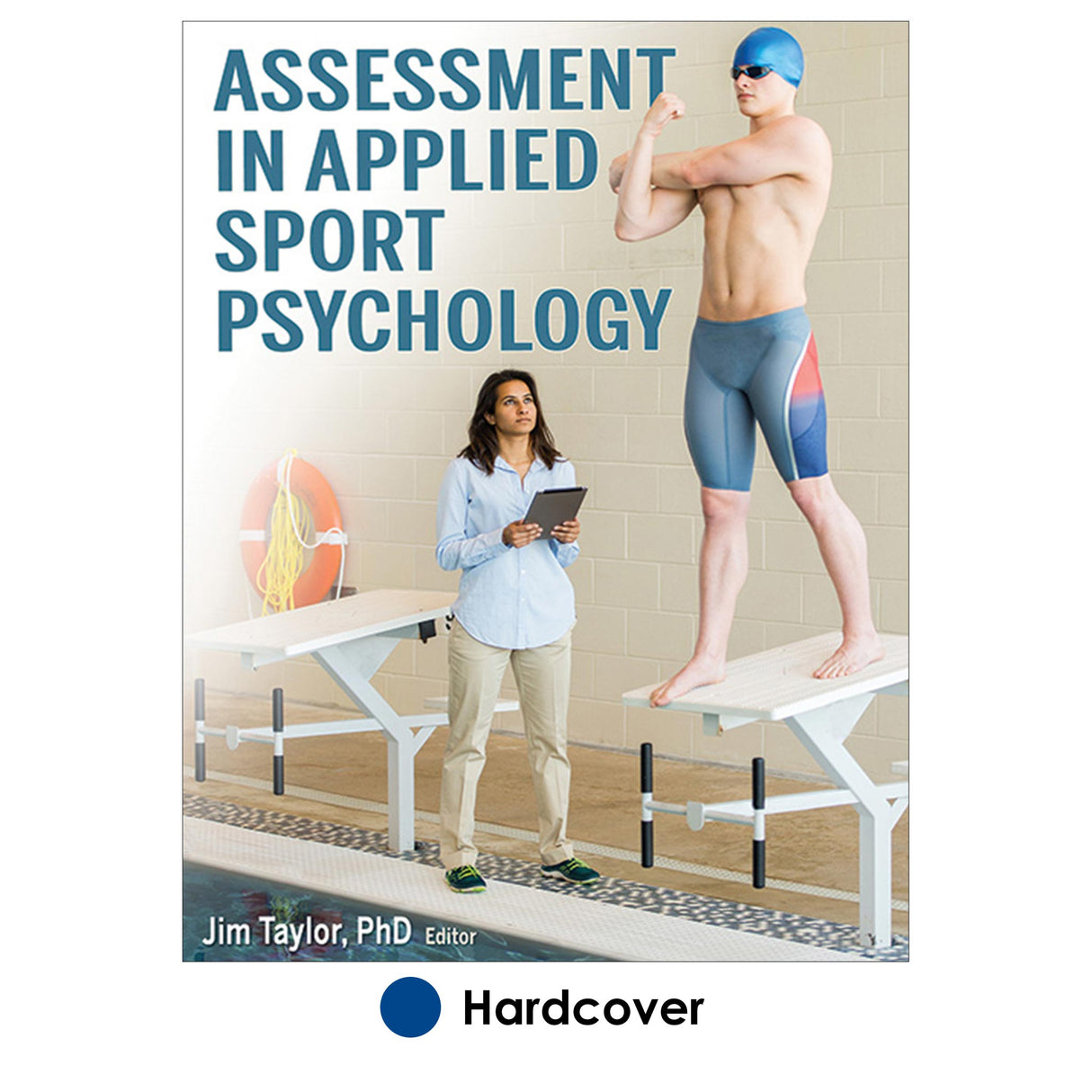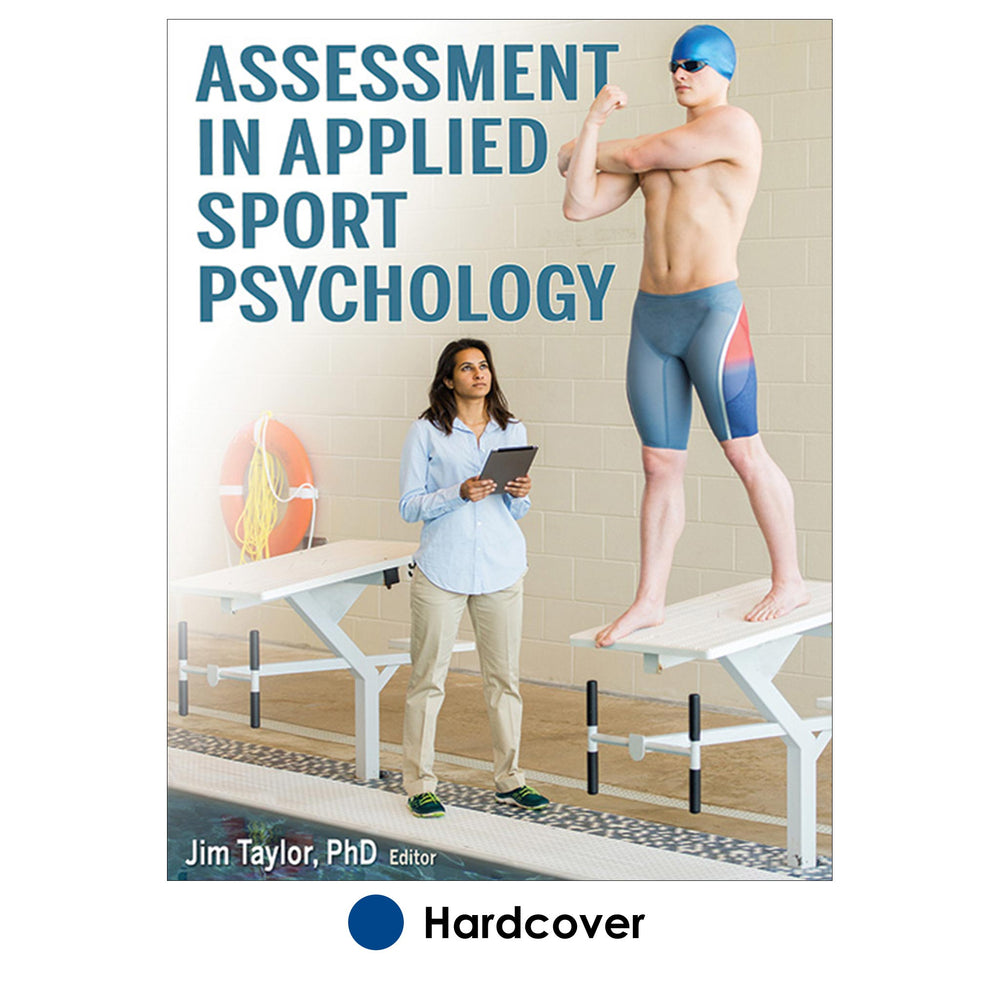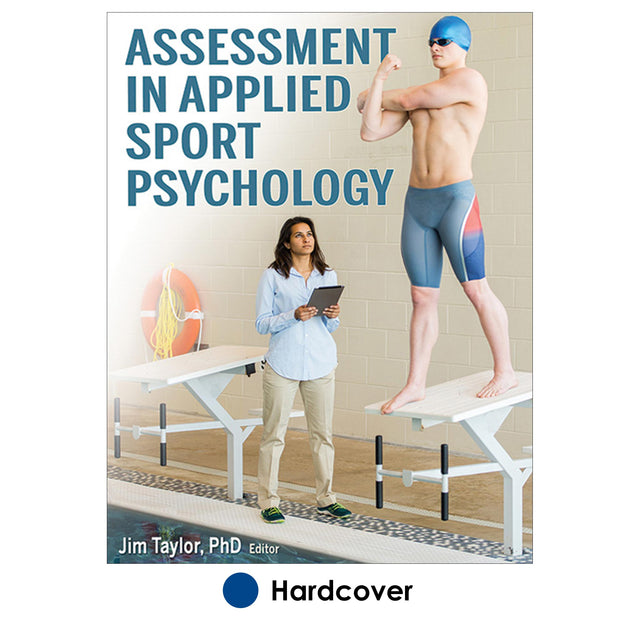Assessment in Applied Sport Psychology
Author: Jim Taylor
$59.00 USD
Assessment in Applied Sport Psychology is a comprehensive resource that offers both students and professionals the opportunity to hone their skills to help their clients, starting with the initial consultation and lasting through a long-term relationship. In this text, Jim Taylor and a team of sport psychology experts help practitioners gain a deep understanding of assessment in order to build trusting relationships and effective intervention plans that address the needs and goals of their clients.
Part I of Assessment in Applied Sport Psychology covers topics such as the importance of assessment, the appropriateness of qualitative and quantitative assessment, ethical issues that can arise from assessment, and the impact of diversity in the use of assessment. Part II introduces readers to six ways that consultants can assess athletes: mental health screening, personality tests, sport-specific objective measures, interviewing, observation, and applied psychophysiology. Chapters in this section explain the strengths and weaknesses of each approach—for example, when traditional pencil-and-paper and observation approaches may be more appropriate than interviewing—and offer consultants a more complete toolbox of assessments to use when working with athletes. Part III addresses special issues, such as career transition, talent identification, and sport injury and rehabilitation. One chapter is devoted to the hot-button issue of sport-related concussions.
Tables at the end of most chapters in parts II and III contain invaluable information about each of the assessment tools described, including its purpose, publication details, and how to obtain it. Chapters also contain sidebars that provide sample scenarios, recommended approaches, and exercises to use with clients.
Assessment in Applied Sport Psychology works toward two main goals. The first is to help consultants gain a complete understanding of their clients through the use of a broad range of assessment tools. The second is to show consultants how to ethically and effectively use assessments to develop a comprehensive understanding of their clients, thus enabling them to assist their clients in achieving their competitive and personal goals.
Audience
Applied professional reference book for clinical sport psychologists and sport psychology consultants, including AASP-certified consultants and CC-AASP candidates; textbook for graduate students in assessment and applied sport psychology courses
Part I: Foundation of Assessment in Sport Psychology Consulting
Chapter 1: Importance of Assessment in Sport Psychology Consulting
Jim Taylor
Assessment Terminology
Purpose of Assessment
Practical Value and Use of Assessment
Assessment Skill Sets
Assessment Is Judgment
Assessment Toolbox
Choosing Assessment Tools
Chapter Takeaways
Chapter 2: Science of Sport Psychology Assessment
Anita N. Lee and Jim Taylor
Assessment for Individuals Versus Groups
Validity and Reliability of Assessments
Determining the Value of Sport Psychology Assessments
Critical Evaluation of Assessment Research
Specificity of Assessment Instruments
Quantitative and Qualitative Assessments
Assessment Myths
Creating Your Own Assessments
Chapter Takeaways
Chapter 3: Ethical Issues in Sport Psychology Assessment
Marshall Mintz and Michael Zito
Ethical Principles
Ethical Guidelines
When Ethical Dilemmas Arise
Chapter Takeaways
Chapter 4: Diversity in Sport Psychology Assessment
Latisha Forster Scott, Taunya Marie Tinsley, Kwok Ng, Jenny Lind Withycombe, and Melanie Poudevigne
Marginalization of Cultural Diversity in Sport Psychology and Assessment
Multicultural Sport Psychology Competencies
Overview of Multicultural Assessment
Assessment Tools
Implications for Consultants
Future Directions for Professional Development
Chapter Takeaways
Part II: Assessment Tools
Chapter 5: Mental Health Screening: Identifying Clinical Issues
Erin N. J. Haugen, Jenni Thome, Megan E. Pietrucha, and M. Penny Levin
Stress
Depression and Suicide
Anxiety
Disordered Eating and Eating Disorders
Attention-Deficit/Hyperactivity Disorder (ADHD)
Substance Use and Abuse
Chapter Takeaways
Chapter 6: Personality Tests: Understanding the Athlete as Person
James Tabano and Steve Portenga
History of Personality Assessment in Sport
Self-Esteem
Perfectionism
Fear of Failure
Need for Control
Chapter Takeaways
Chapter 7: Inventories: Using Objective Measures
Graig M. Chow and Todd A. Gilson
Importance of Practicality When Choosing Assessments
Benefits of Objective Measures in Consulting with Athletes
Assessment Tools for Individual Athletes
Mental Skills and Techniques
Chapter Takeaways
Chapter 8: Interviewing: Asking the Right Questions
Jim Taylor, Duncan Simpson, and Angel L. Brutus
Importance of Client Information
Best Practices of Interviewing
Sport Interviewing Protocol
Sport-Clinical Intake Protocol
Chapter Takeaways
Chapter 9: Observation: Seeing Athletes on the Field
Tim Holder, Stacy Winter, and Brandon Orr
Underlying Professional Philosophy
Use and Benefits of Direct Observation
Categories of Observational Assessment
Observation Assessment Tools
Limitations and Concerns
Chapter Takeaways
Chapter 10: Applied Psychophysiology: Using Biofeedback, Neurofeedback, and Visual Feedback
Sheryl Smith, Melissa Hunfalvay, Tim Herzog, and Pierre Beauchamp
Stress Response and Self-Regulation
Benefits of Psychophysiological Assessment
Biofeedback and Neurofeedback Assessment
Visual Assessment
Chapter Takeaways
Part III: Special Issues in Assessment
Chapter 11: Coach, Team, and Parent Assessments
Andy Gillham, Travis Dorsch, Barbara J. Walker, and Jim Taylor
Coach Assessment
Team Assessment
Parent Assessment
Chapter Takeaways
Chapter 12: Talent Identification
Barbara B. Meyer, Stacy L. Gnacinski, and Teresa B. Fletcher
Talent Identification Models and Research
Assessment of Psychosocial Factors Linked to Talent in Sport
Behavioral Observation
Qualitative Interviews
Implications for Consultants
Chapter Takeaways
Chapter 13: Sport Injury, Rehabilitation, and Return to Sport
Monna Arvinen-Barrow, Jordan Hamson-Utley, and J.D. DeFreese
Assessment of Psychosocial Factors Linked to Sport Injury
Assessment for Musculoskeletal Sport Injury
Chapter Takeaways
Chapter 14: Assessment and Management of Sport-Related Concussions
Robert Conder and Alanna Adler Conder
SRC Consultation Essentials
Components of SRC Assessment
Role of Assessment in RTL
Chapter Takeaways
Chapter 15: Career Transition
Claire-Marie Roberts and Marisa O. Davis
Athletic Career Transitions
Key Issues in Consultation and Recommendations for Assessment
Retirement
Postsport Career Planning and Development
Limitations and Concerns
Chapter Takeaways
Chapter 16: Systems Approach to Consulting in Sport Organizations
Charles A. Maher and Jim Taylor
Systems Approach
Identifying Assessment Needs
Determining Readiness for Assessment Services
Chapter Takeaways
Chapter 17: Consultant Effectiveness
Stephen P. Gonzalez, Ian Connole, Angus Mugford, and Jim Taylor
Benefits of Assessing Consultant Effectiveness
Assessing Consultant Effectiveness
Chapter Takeaways
Jim Taylor, PhD, CC-AASP, is an internationally recognized consultant and presenter on the psychology of sport and parenting. He has served as a consultant for the U.S. and Japanese ski teams, the United States Tennis Association, and USA Triathlon. He has worked with professional and world-class athletes in tennis, skiing, cycling, triathlon, track and field, swimming, golf, and many other sports. He has been invited to lecture by the Olympic Committees of Spain, France, Poland, and the United States, and he has been a consultant to the athletic departments at Stanford University and the University of California, Berkeley. Taylor has authored or edited 18 books, published more than 800 articles, and given more than 1,000 workshops and presentations throughout North and South America, Europe, and the Middle East.
A former world-ranked alpine ski racer, Taylor is a second-degree black belt and certified instructor in karate, a marathon runner, and an Ironman triathlete. He earned his PhD in psychology from the University of Colorado. He is a former associate professor in the school of psychology at Nova University and a former clinical associate professor in the sport and performance psychology graduate program at the University of Denver. Taylor is currently an adjunct faculty member at the University of San Francisco.





